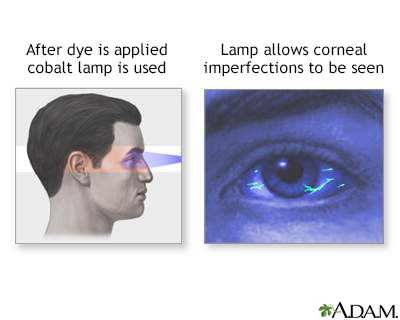Pregnancy SmartSiteTM
DefinitionThis is a test that uses orange dye (fluorescein) and a blue light to detect foreign bodies in the eye. This test can also detect damage to the cornea. The cornea is the outer surface of the eye. How the Test is PerformedA piece of blotting paper containing the dye is touched to the surface of your eye. Sometimes the dye comes in a drop form which also contains anesthetic. You are asked to blink. Blinking spreads the dye and coats the tear film covering the surface of the cornea. The tear film contains water, oil, and mucus to protect and lubricate the eye. The health care provider then shines a blue light at your eye. Any problems on the surface of the cornea will be stained by the dye and appear green under the blue light. The provider can determine the location and likely cause of the cornea problem depending on the size, location, and shape of the staining. How to Prepare for the TestYou will need to remove your eyeglasses or contact lenses before the test. How the Test will FeelIf your eyes are very dry, the blotting paper may be slightly scratchy. The dye may cause a mild and brief stinging sensation if there is no anesthetic used. Why the Test is PerformedThis test is to:
Normal ResultsIf the test result is normal, the dye remains in the tear film on the surface of the eye but does not show any abnormal areas. What Abnormal Results MeanAbnormal results may point to:
Often the test is done to check for any of the conditions listed above. RisksIf the dye touches the skin, there may be a slight, brief, discoloration. It may stain your clothing or other fabric. ReferencesFowler GC. Corneal abrasions and removal of corneal or conjunctival foreign bodies. In: Fowler GC, ed. Pfenninger and Fowler's Procedures for Primary Care. 4th ed. Philadelphia, PA: Elsevier; 2020:chap 200. Knoop KJ, Dennis WR. Ophthalmologic procedures. In: Roberts JR, Custalow CB, Thomsen TW, eds. Roberts and Hedges' Clinical Procedures in Emergency Medicine and Acute Care. 7th ed. Philadelphia, PA: Elsevier; 2019:chap 62. | |
| |
Review Date: 2/12/2023 Reviewed By: Franklin W. Lusby, MD, Ophthalmologist, Lusby Vision Institute, La Jolla, CA. Also reviewed by David C. Dugdale, MD, Medical Director, Brenda Conaway, Editorial Director, and the A.D.A.M. Editorial team. The information provided herein should not be used during any medical emergency or for the diagnosis or treatment of any medical condition. A licensed medical professional should be consulted for diagnosis and treatment of any and all medical conditions. Links to other sites are provided for information only -- they do not constitute endorsements of those other sites. No warranty of any kind, either expressed or implied, is made as to the accuracy, reliability, timeliness, or correctness of any translations made by a third-party service of the information provided herein into any other language. © 1997- A.D.A.M., a business unit of Ebix, Inc. Any duplication or distribution of the information contained herein is strictly prohibited. | |

 Fluorescent eye te...
Fluorescent eye te...
